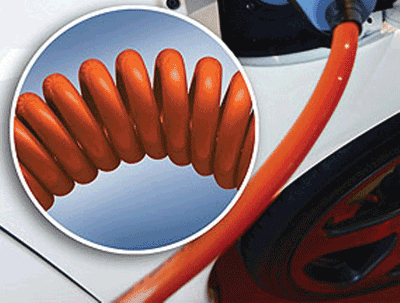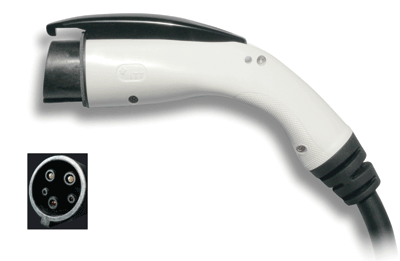Recent breakthroughs in standards, cabling, and connectors are improving the consumer’s EV experience
BY MIKE GARDINER
Product Manager
ITT Corporation
www.itt.com
Electric vehicles are becoming more prevalent in today’s society. Some consumers are choosing hybrid and electric vehicles because of the rising price of gas; others are switching out of concern for the environment. Whatever the reason, it is clear that electric vehicles are a more economically and environmentally friendly alternative to traditional, gas-powered vehicles.
Manufacturers are continuously developing new designs and technologies to keep pace with new automotive demands. The recent changes in consumer trends have steered automotive manufacturers away from producing large SUVs to increased production of smaller, compact, more fuel-efficient vehicles powered by electric or hybrid engines.
Several factors have delayed the mass acceptance of these vehicles. The lack of an established charging infrastructure to support the vehicles has certainly hampered their sales. Another source of skepticism by the general public is the perceived inconvenience and inefficiency of the electric vehicle’s charging system. The energy storage capacity of the lithium-ion battery that powers the electric motor — and determines the distance a driver can travel between charges — is much less than consumers desire. This is compounded by the fact that the battery has required a relatively long time to recharge.
Recent breakthroughs have led to a possible solution to this problem. Engineers have found a way to shorten the charge time of an electric vehicle’s battery, easing the driver’s anxiety and providing more consumer confidence in the cars, which may lead to growth in the industry.
The shift to hybrid and electric vehicles required the industry to develop the J1772 vehicle charging standard to ensure infrastructure compatibility. Vehicle manufacturers have quickly adopted the J1772 standard, and manufacturers have in turn developed customized, high-amperage interconnect systems for recharging vehicles that meet both industry safety specifications and customer ergonomic and performance requirements.
SAE J1772 charging standard
The Society of Automotive Engineers (SAE) established the SAE J1772 Electric Vehicle and Plug In Hybrid Electric Vehicle Conducive Charge Coupler specification to cover the electrical and physical performance requirements and communication procedures for the charge systems of electric vehicles. This charging standard was adopted in January 2010 by both the United States and Japan for Level I and Level II electric vehicle charging, and has been accepted by many of the leading electric vehicle manufacturers including GM, Ford, Honda, Nissan, and Toyota.
These levels are defined in the following manner:
• Level I is ac energy to the vehicle’s on-board charger from a common grounded household receptacle, commonly referred to as a 15-A/120-Vac outlet.
• Level II is 208-240 Vac, single-phase energy to the vehicle’s on-board charger. The maximum current specified is 80 A (continuous) with a branch circuit breaker rated per NEC 625. It is recommended that the current rating of residential EVSE (electric vehicle service equipment) be limited to 32 A (40-A branch breaker).
Wires and cable
The advanced electric vehicle charging solution defined by SAE J1772 uses rugged, high-power cable that is UL certified. The EVE- and EVJE-type cable is made of thermoplastic elastomer that provides high dielectric strength and electrical performance compared to conventional EVT-type cable made from thermoplastic material.
The EVE cable is more flexible in cold conditions (see Fig. 1 ) and has a lower brittle point that delivers better tear resistance in cold weather, making it more suitable for outdoor environments than EVT cables.
The TPE’s high-density polyethylene is also more resistant to moisture and acids than polyolefin material, delivering a long operational life in electric vehicle charging applications.

Fig. 1: Thermoplastic elastomer (TPE) cables are able to handle higher voltages and currents, while providing better flexibility and tear resistance than in the past.
Connecting cable to car
Manufacturers addressing the need for a high-amperage solution have developed an electric vehicle charging connector that delivers a 75-A Level II charge while delivering low-temperature rise.
One example of this technology is ITT’s EVC Series connectors (see Fig. 2 ), which provide a charging time that is 2.5 times faster than 30-A Level II technologies. This second-generation connector utilizes Louver Band technology, and consists of the J2CE connector and the J2IV inlet.

Fig. 2: New connector designs, such as the EVC connector from ITT, aid in faster vehicle charging while improving ergonomics and safety.
The female contacts in the Louver Band design are made of a special copper alloy that enables high-reliability and-performance characteristics. The system is designed for a minimum of 10,000 cycles of mechanical operation and meets UL50 Type 3R/3S sealing for weather protection.
The system is designed to exceed the electrical and mechanical UL specifications, as well as the SAE 1772 specifications across the power curve. The charging solutions feature highly efficient power contacts to provide flexible functionality, with minimal modifications, across a power curve ranging from 15 A/120 V to 75 A/240 V. Five contacts (two power, one ground, and two signal) make up the J1772 inlet, which has a touch-proof seal on power and ground contacts.
Safety
Safety systems, including hardware and software, are built into the electric vehicle charging connector, as well as the electric vehicle and charging stations themselves. The safety mechanisms monitor voltage, current, and heat; specify the amperage that can go through the charging connector; sensors disengage any drive function while a connector is plugged into the vehicle. Both the 1st Generation EVC Series and the 2nd Generation connector designs passed the full range of the governing body testing, as well as SAE, IEC and GB standards on the first attempt.
The electric vehicle charging connector features a standardized contact system and modular design (in everything from the tooling to the connector handle) makes it suitable for use worldwide. High quality materials in the connector contacts and handle ensure proper heat management.
The electric vehicle charging connector easily meets the UL temperature rise standard that mandates an increase below 50C from ambient when activated. As specified above, the EVC Series connector contacts use a copper alloy on the female contacts system. Thermal plastic with a high UV resistance rating is used for the handle, with advanced plastic color particles added to keep the handle white, even when exposed to harsh environments over time.
Ergonomics
As is the case for many things, look and feel plays a large role in making the user’s charging experience positive. For that reason, several cosmetic changes have been made to the next generation of 75-A electric vehicle charging connectors, including minimizing the number of screws and re-design of the handle based on user feedback, as well as the creation of a new locking-latch mechanism.
For the new mechanism, the latch is exposed and raised from the handle body, allowing for easier engagement with standard inlets. The connector has a metal latch, versus plastic, to ensure ruggedness and reliability. Metal also provides a better tactile feel when the coupler is connector to the vehicle.
Advertisement
Learn more about ITT Interconnect Solutions





